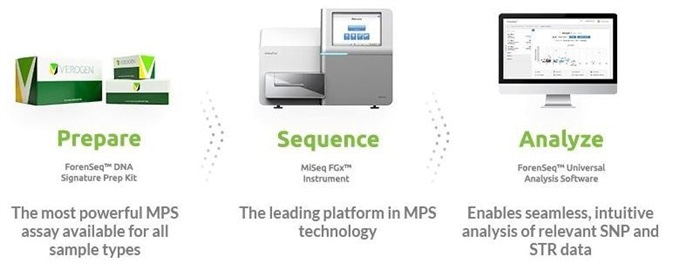Forensic science and law enforcement face significant challenges with missing person cases because of the high amount of open cases, and DNA samples being old, left vulnerable in harsh conditions, and frequently comprising degraded DNA.
A prerequisite of the traditional technology that uses capillary electrophoresis is that the initial DNA should be in fairly good condition, because of the size of the short tandem repeat (STR) amplicons being probed.
In alternative cases, specialized testing employing mitochondrial DNA (mtDNA) may be the only choice if the starting DNA is unable to acquire a viable STR result.
The broad application of next-generation sequencing (NGS) in many fields of applied sciences and molecular biology research enables forensic scientists across the globe to take advantage of the full power of targeted NGS to solve complex missing person cases.
Verogen provides a complete, fully validated DNA-to-data solution created for forensic genomics. Its MiSeq FGx System can efficiently provide results, with the potential to enhance the speed of investigations.

Image Credit: Verogen, Inc.
Disaster Victim Identification
Victims of mass fatalities can be identified through genetic analysis when traditional techniques cannot be employed or cannot generate conclusive results.
The maximum amount of data from a known reference sample or evidence can be extracted because next-generation sequencing (NGS) has no appropriate limit on the number of loci that can be investigated at the same time.

Image Credit: Verogen, Inc.
NGS to Identify Missing Persons & Disaster Victims
Sequencing by synthesis (SBS) technology provides a significantly parallel approach for the sequencing of forensic PCR amplicons, both mitochondrial and nuclear.
NGS allows scientists to employ a single platform with an optimized workflow to manage the broadest range of complex samples frequently found in disaster victims and missing person cases.
The forensic genomics solution from Verogen entails a concentrated range of phenotypic SNPs, identity SNPs, and biogeographic ancestry SNPs to help with facial reconstruction and the exclusion of candidate identifications.
Verogen now provides the first completely integrated, sample-to-result forensic mitochondrial solution with the inclusion of the ForenSeq mtDNA Whole Genome Kit and the ForenSeq mtDNA Control Region Kit.

Image Credit: Verogen, Inc.
Validated Solutions to Identify Missing Persons
STR & SNP Analysis with NGS
NGS allows for the genetic analysis of huge numbers of globally relevant STR markers and dense SNP sets in one test. Learn More »

Image Credit: Verogen, Inc.
Forensic mtDNA Sequencing
NGS offers deep coverage of mtDNA to acquire genetic data from small forensic samples discovered in a substandard condition. Learn More »

Image Credit: Verogen, Inc.
Additional Resources
mtDNA Sequencing to ID Skeletal Remains
Dr. Mitch Holland of Penn State describes how high-throughput sequencing is allowing the effectiveness of mtDNA heteroplasmy in forensic research to be realized.

Image Credit: Verogen, Inc.
A Comprehensive Next-Generation Sequencing Workflow for Severely Degraded Nuclear DNA

Image Credit: Verogen, Inc.
Advance Beyond the DNA Profile to Human Identification
A technology that yields effective investigative intelligence from a DNA sample is required when human identification is important.

Image Credit: Verogen, Inc.
About Verogen, Inc.
Introducing the world’s first sequencing company solely dedicated to forensic science. Forensic laboratories are unique, and require unique scientific solutions.
We get this. Because we live it. We create thoughtfully tailored genomic solutions for forensic DNA labs. The kinds of tools we longed for when we worked in those labs ourselves. We formed an independent company with dedicated resources because we believe it’s the best way to fully address those unique needs.
The last few decades have seen tremendous advancements in molecular biology techniques, such as massively parallel sequencing. While our colleagues in other scientific fields have embraced and benefited from these improvements, forensic genomics has yet to realize the potential of the evolved technology. It’s time we had modern tools tailored to our needs.
Verogen understands this. Our sole focus is to advance science to help unlock the true potential of forensic genomics. Powered by Illumina technology and free of legacy method allegiance, we are uniquely positioned to support forensic labs with innovative solutions purpose-built for the challenges of DNA identification. Working in partnership with the community, we can elevate the forensic genomics lab’s role in preserving public safety—and improve global justice for all.
Sponsored Content Policy: News-Medical.net publishes articles and related content that may be derived from sources where we have existing commercial relationships, provided such content adds value to the core editorial ethos of News-Medical.Net which is to educate and inform site visitors interested in medical research, science, medical devices and treatments.